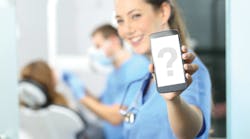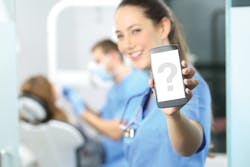Jo Cleasby, RDH
Technology is in our lives whether we like it or not, and it seems to be advancing at the speed of light. I think we’ve all had to succumb to buying a cell phone because it seems we can’t do anything without one these days.
However, where do we draw the line when it comes to using cell phones in the dental office and in operatories? They’re so easy to use by making it fast and easy to look up information, which is literally right at our fingertips.
What is the cell phone policy in your office? They’re here to stay, and employees will continue to use them. I can’t say that I have actually seen employees using their cell phones in other medical offices, but the fact is that people are using them at all times of the day. Everyone is hooked on the social media craze, whether it’s Facebook, Twitter, Snapchat, or some other trend. Used properly, social media, coupled with cell phones, can actually help sell your practice to the right people.
© Antonio Guillem | Dreamstime.com
Connecting with patients via cell phone
Competition for patients is strong, and encouraging them to become involved in your practice can help it grow. Hashtag this, tweet that, post this . . . these are all ways we connect with people these days. Imagine a mother and father who want to capture their child’s first moment in the dental chair and they don’t have their phone with them. Taking that photo for them could promote your practice by sharing that first-time patient’s memory of a lifetime. Most offices have their own Facebook or Instagram accounts, and a cell phone is the perfect way to post photos. It’s even a good way to post about an opening in your schedule.
The latest social media trend is the “in my feelings” videos traveling the web. If it weren’t for cell phones, none of this would even be possible. No one is using a camcorder anymore to capture these moments. Patients can take selfies in your chair and post them to their social media, which is then seen by their friends, who could become your future patients.
I know many patients who do not own a personal computer, so their cell phone serves as their computer. Many patients want to see their x-rays or a photo that was taken in the operatory, and the cell phone is an easy way to send these to patients. I’ve taken my phone out many times during a patient visit to take a photo, which I then send directly to a referring oral surgeon or periodontist.
Also, many photos of before-and-after results have been taken during root planing and scaling procedures, after whitening, or after many other types of procedures. The cell phone is very effective in these instances as our office does not have an intraoral camera.
Like most offices, we are connected to many of our patients on a more personal level. Some patients are like family and they want to see what we’re like outside of the dental office in our “normal” lives. They share some of their personal photos with us and we do the same in return. This helps build rapport with our patients.
I’m part of a community of dental hygienists who market and sell a particular brand of electric toothbrush. In order to share this innovative technology with my patients, I need my phone to share a code in order for them to purchase this toothbrush. Technology like this is truly priceless and a time saver.
I have shown many patients where to buy certain products that would be beneficial to their hygiene maintenance, or to look up a physician’s name to inquire about their prophylactic protocol with regard to premedication or surgery dates. Patients simply don’t come prepared to their appointments and using the cell phone for these purposes is clearly needed as some offices do not have internet access in their operatories. Also, we can connect with patients’ physicians in a timely manner rather than disturbing the front office.
Connecting with dentist and coworkers via cell phone
Many offices have started to use Apple watches to page the doctor to come in for an exam if they don’t have a pager system in the office. Or they use the watches to request help in an operatory, such as an assistant who needs help with probe readings or a hygienist who needs some supplies. In these cases, the watch or a phone must be on the person or within a certain distance in order for them to work properly.
There is not much difference in this as compared to using headsets. Most offices use some type of software as a service (SaaS) platform that integrates with their practice management software to communicate with patients regarding their upcoming appointments. A cell phone in your operatory can enable this functionality. We’ve shown patients how to respond to their text messages, as well as how to leave an instant review about their experience in the office on their phone after their appointment. Changes to text message preferences are easily made with the use of the cell phone, because most SaaS platforms are mobile-friendly.
What about in an emergency? I’ve missed calls from my son’s school if he’s had an accident or become sick and needed to be picked up right away. If your office has a strict policy of no cell phones in the operatory, then guidelines need to be implemented to have emergency messages delivered to staff immediately, especially if it involves a child with specific medical needs.
As dental hygienists, we must be professional about our cell phone use. I do not believe it’s right for us to have our phones out on the counter in order to constantly check the latest tweet or snap. Not only is this unprofessional, but it is a potential hazard and the phone can become contaminated. We can, however, connect with our patients via cell phone, whether it be to educate them or to look up a current medication. Education is critical to our patients and sites such as Colgate offer information we can share.
Patients must come first, of course, so an office policy must be in place about the use of cell phones. In a poll that I conducted on a dental social media site, answers were about 50/50 among hygiene professionals regarding the use of cell phones in operatories. Office staff definitely need to be on the same page and agree about the use of cell phones in the operatories. It is way too easy to get on Facebook or catch up on the latest trends on Pinterest or Instagram, which should be avoided.
We must face the fact that cell phones are here to stay. Ninety-five percent of the population have them.1 To have a device-free office would be ideal, but that’s just not realistic today. There is no real safety concern when it comes to cell phone use in the operatory. However, it can be disruptive and we as health-care professionals experience that with our patients. But cell phones can certainly be very powerful tools if they’re used properly in our clinical settings.
Reference
1. Mobile fact sheet. Pew Research Center website. http://www.pewinternet.org/fact-sheet/mobile/. Published February 5, 2018.
Jo Cleasby, RDH, has been a registered hygienist for more than 25 years and works in the suburbs of Chicago. She has enjoyed her career, including many opportunities outside of the clinical setting that allowed her to grow exponentially in the dental community. Her true passion is clinical hygiene, helping patients obtain their ultimate smiles and educating them on the connection to whole body health. Outside of the office she enjoys spending time and traveling with her husband and two sons.








